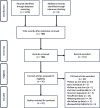The long-term rate of change in lung function in urban professional firefighters: a systematic review
- PMID: 30189854
- PMCID: PMC6128005
- DOI: 10.1186/s12890-018-0711-8
The long-term rate of change in lung function in urban professional firefighters: a systematic review
Erratum in
-
Correction to: The long-term rate of change in lung function in urban professional firefighters: a systematic review.BMC Pulm Med. 2019 May 6;19(1):86. doi: 10.1186/s12890-019-0850-6. BMC Pulm Med. 2019. PMID: 31060541 Free PMC article.
Abstract
Background: Despite the known occupational hazards, it is not yet clear whether long-term career firefighting leads to a greater rate of decline in lung function than would normally be expected, and how this rate of change is affected by firefighting exposures and other risk/protective factors.
Methods: A systematic search of online electronic databases was conducted to identify longitudinal studies reporting on the rate of change in the forced expiratory volume in one second (FEV1) of forced vital capacity (FVC). Included studies were critically appraised to determine their risk of bias using the Research Triangle Institute Item Bank (RTI-IB) on Risk of Bias and Precision of Observational Studies.
Results: Twenty-two studies were identified for inclusion, from four different countries, published between 1974 and 2016. Examined separately, studies were categorised by the type of firefighting exposure. Firefighters experienced variable rates of decline in lung function, which were particularly influenced by cigarette smoking. The influence of routine firefighting exposures is unclear and limited by the methods of measurement, while firefighters exposed to 'non-routine' severe exposures unanimously experienced accelerated declines.
Conclusions: The data provided by longitudinal studies provide an unclear picture of how the rate of change in lung function of firefighters relates to routine exposures and how it compares to the rate of change expected in a working-age population. Non-smoking firefighters who routinely wear respiratory protection are more likely than otherwise to have a normal rate of decline in lung function. Exposure to catastrophic events significantly increases the rate of decline in firefighter lung function but there is limited evidence detailing the effect of routine firefighting. Future studies will benefit from more robust methods of measuring exposure.
Trial registration: International Prospective Register of Systematic Reviews (PROSPERO), registration number ( CRD42017058499 ).
Keywords: Exposure; Firefighters; Firefighting; Longitudinal; Lung function; Spirometry; Systematic review.
Conflict of interest statement
Ethics approval and consent to participate
Not applicable.
Consent for publication
Not applicable.
Competing interests
The authors declare that they have no competing interests.
Publisher’s Note
Springer Nature remains neutral with regard to jurisdictional claims in published maps and institutional affiliations.
Figures
Similar articles
-
Change in lung function over time in male metropolitan firefighters and general population controls: a 3-year follow-up study.J Occup Health. 2013;55(4):267-75. doi: 10.1539/joh.12-0189-oa. Epub 2013 Jun 24. J Occup Health. 2013. PMID: 23796594
-
Blood Leukocyte Concentrations, FEV1 Decline, and Airflow Limitation. A 15-Year Longitudinal Study of World Trade Center-exposed Firefighters.Ann Am Thorac Soc. 2018 Feb;15(2):173-183. doi: 10.1513/AnnalsATS.201703-276OC. Ann Am Thorac Soc. 2018. PMID: 29099614 Free PMC article.
-
Longitudinal lung function in urban firefighters: A group-based multi-trajectory modelling approach.Respirology. 2023 Mar;28(3):247-253. doi: 10.1111/resp.14382. Epub 2022 Sep 30. Respirology. 2023. PMID: 36180416
-
The Effect of Fire Smoke Exposure on Firefighters' Lung Function: A Meta-Analysis.Int J Environ Res Public Health. 2022 Dec 14;19(24):16799. doi: 10.3390/ijerph192416799. Int J Environ Res Public Health. 2022. PMID: 36554677 Free PMC article. Review.
-
[Cancer risk in firefighters].Rev Med Chil. 2023 Jul;151(7):929-933. doi: 10.4067/s0034-98872023000700929. Rev Med Chil. 2023. PMID: 39093182 Review. Spanish.
Cited by
-
Health risks and mitigation strategies from occupational exposure to wildland fire: a scoping review.J Occup Med Toxicol. 2022 Jan 4;17(1):2. doi: 10.1186/s12995-021-00328-w. J Occup Med Toxicol. 2022. PMID: 34983565 Free PMC article.
-
Comparison of the risks of occupational diseases, avoidable hospitalization, and all-cause deaths between firefighters and non-firefighters: A cohort study using national health insurance claims data.Front Public Health. 2023 Jan 16;10:1070023. doi: 10.3389/fpubh.2022.1070023. eCollection 2022. Front Public Health. 2023. PMID: 36726614 Free PMC article.
-
Perceptions of lung function surveillance in urban firefighters.Ann Work Expo Health. 2023 Sep 21;67(8):926-937. doi: 10.1093/annweh/wxad040. Ann Work Expo Health. 2023. PMID: 37499229 Free PMC article.
-
An examination of psychometric properties of study quality assessment scales in meta-analysis: Rasch measurement model applied to the firefighter cancer literature.PLoS One. 2023 Jul 26;18(7):e0284469. doi: 10.1371/journal.pone.0284469. eCollection 2023. PLoS One. 2023. PMID: 37494348 Free PMC article.
-
The status and influencing factors of lung ventilation function in employees exposed to dust in enterprises of the XPCC, China.Front Public Health. 2024 Apr 26;12:1370765. doi: 10.3389/fpubh.2024.1370765. eCollection 2024. Front Public Health. 2024. PMID: 38737857 Free PMC article.
References
Publication types
MeSH terms
LinkOut - more resources
Full Text Sources
Other Literature Sources
Medical


